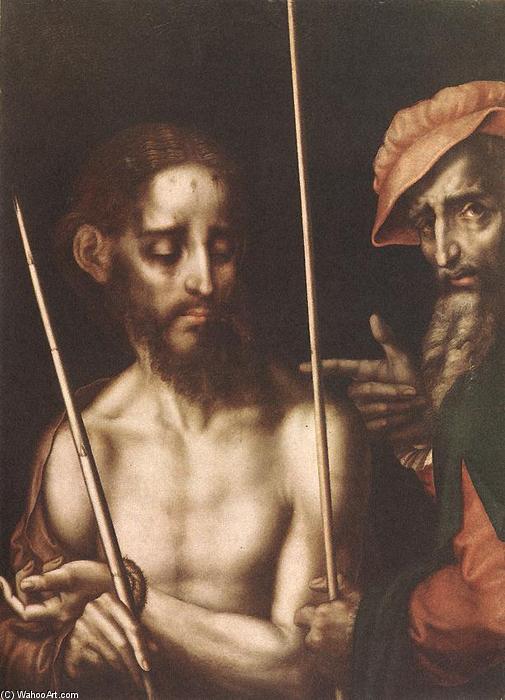
Hispanic Society of America, New York, United States
Pacheco, in this part of his studies, observed that some artists have not correctly represented Christ as Ecce Homo, a passage in which Jesus Christ, after being crowned with the crown of thorns, was presented to the people by Pontius Pilate. After an iconographic analysis of the passage in which Christ was crowned with the crown of thorns, the author noted that it is to be believed that Christ in this scene was used, besides the crown of thorns and the purple cloak, his cane in his right hand instead of the scepter. That’s the reason why he criticised – affirming that was a lack of decorum (Falta de decoro) with the Holy Scriptures – when Pablo de Cspedes painted Christ in a retable at the altarpiece of the Company of Cordoba without a cane in His hand; and mainly Luis de Morales, who, according to Pacheco, executed artworks in which Christ is without the cane and the crown of thorns, having only the signs of the wounds, as well as artworks in which Christ is carrying the cross on his back without the crown of thorns (considered terrific untruthfulness to the biblical sources). According to art historians, however, there is no record of works by Luis and Morales in which Christ does not present the cane.
“And to prove that Christ, our Lord, took off all the royal insignia with which they had mocked him a short time before, the Evangelist St. John confirms it a second time, when Pilate said to them Ecce Rex Vester ‘See here your King’. All of which was to verify the costume that he took out, and I have tried, to warn the painters of what I have noted, especially in an Ere Hore that Pablo de Céspedes painted in the altarpiece of the Company of Cordoba and some of Morales, that of Badaxoz, painted without a reed in his hand; and Morales took even more license, who painted some without a crown of thorns, with only the signs of the wounds and also carrying the cross on his back, he used this liberty or lack of decorum in history”.
“Y para prucha de que Cristo, Señor nuestro, saco todas las insignias reales con que le habian poco antes escarnecido lo confirma adelante segunda vez el Evangelista San Juan, cuando les dixo Pilatos Ecce Rex vester ‘Veis aqui vuestro Rey’. Todo lo cual había de verificar el traje que sacó, y yo he probado, para advertir a los pintores lo que tengo anotado, en especial, en un Ere Hore que pintó Pablo de Céspedes en el retablo de la Compañía de Córdoba y en algunos de Morales, el de Badaxoz, pintados sin caña en la mano;y aun Morales tomó más licencia, que pintó algunos sin corona de espinas, con solas las señales de las heridas y también llevando la Cruz a cuestas usó desta libertad o falta de decoro en lo historial.”

painting
Media Materials
Painting
Iconclass Number
73D36
Pacheco 1990, 644, n.26-27



